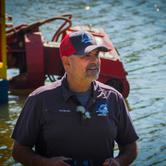Algae Outbreak is a sign that Your Pond Needs Dredging
Artificial ponds require regular maintenance to prevent nuisances such as algae outbreaks, fish die-offs, and, most importantly, the lake from turning into a muddy marsh. Whether the pond is managed by a golf course, HOA, or private party, the result of a poorly maintained pond is always the same. Smelly, unsightly water and weeds so thick you'd think you were looking at a patch of jungle. Most people tasked with the care and maintenance of a pond will throw in a few gallons of chemicals every few months, and that's that. While herbicides and other chemicals work to a point, there will come a time when not even the most vigorous application can stop an algae outbreak. At this point, dredging is your only option. It will help remove any excess organic sediment from the bottom of the pond that's feeding the algae outbreak. We'll look at four signs that usually indicate that it's time to call the dredging professionals to get everything under control.
Nuisance Algae
Algae outbreaks can choke a pond to death in a few weeks. In some cases, they can be highly toxic to humans and animals. Every single year, there are countless news stories about local ponds being closed by city officials during the summer. Blue-green algae are highly toxic, and just a little bit can seriously sicken or kill a human or pet. Dredging removes the organic layer of sediment at the bottom of the pond. If left untouched, the pile of sediment will only continue to grow, as beneficial bacteria that feed on the organic matter cannot thrive there, where oxygen and light are scarce.
Reduction in Water Life
Have you noticed a big fish die-off recently? Are the carcasses of water birds regularly found around your pond? All of these signs point to something wrong with the quality of the water. Fish die-offs can occur when an algae outbreak is so severe that it sucks all of the available oxygen out of the water. Fish and other aquatic life will then suffocate. While fish die-offs can happen at any time of the year, they occur most often in the summertime. When they do, sometimes water birds are killed as well. If a toxic blue-green algae outbreak were to happen, it could destroy both fish and fowl when the birds ingest the fish that have consumed the poisonous algae.
A decrease in Pond Size
As ponds go through their life cycle, they tend to attract a lot of sediment. As time goes by, the sediment will continue to grow and eventually fill the body of water. This results in a decrease in both the width and depth of the pond. Sediment is organic matter. Fish and animal waste, dead leaves, and even rotting carcasses are all-natural food sources for algae. As they enter the water, they descend to the pond's bottom. With little oxygen and almost no light, the entire area becomes a dead zone where nothing can thrive except for the organic matter, which leases high amounts of nutrients into the water.
Increase in Vegetation
If left to their own devices, ponds will naturally attract vegetation, most prominent along the edges and shore. This vegetation is fed in significant part by the massive ball of organic muck that resides at the bottom of the pond. Vegetation increases are easy to spot but not easy to eliminate. Herbicides often don't work for more significant weeds such as cattails, and the only other immediate option is to hire a crew of manual laborers to put on rubber galoshes and manually start pulling weeds. These "solutions" are expensive and do nothing to fix the underlying problem.
Pond Dredging
Throwing herbicides and other potentially dangerous chemicals into a pond hardly constitutes a good maintenance plan. Eventually, the forces of nature will conspire to reclaim the wetland and turn it into a swampy, smelly, unsightly marsh. Having your pond(s) dredged at least once a year will ensure they stay as pristine as the day they were first filled with water. If you are responsible for maintaining a pond at your HOA, golf course, or private residence and are interested in learning more about the dredging services provided by American Underwater Services, you can contact us by calling (817) 377-8512 or through our website.




